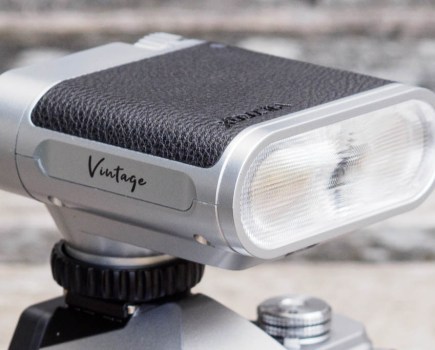Canon PowerShot G7 X Review – Introduction
Compact is becoming the most fiercely contested market in the world of photography for two reasons in particular. With cameras on smartphones threatening to steal ground from compacts as they get more sophisticated, and interchangeable lens compact system cameras challenging DSLR quality, compact cameras now face the most immediate threat to their existence.
However, Canon’s PowerShot series is long established as one of the market leaders and the new G7 X joins the Japanese camera giant’s range to shore things up, just above the 1/1.7in sensor PowerShot S120 and G16, and sitting below the G1 X Mark II which has a larger, 1.5in sensor.
This is the first time that Canon has offered a 1-in sensor product of this type, finally providing some direct competition to Sony’s award-winning RX100 series. While the smaller cameras in Canon’s range are better suited to short trips and party pictures, the G7 X is intended to be a perfect all-rounder for people who want a capable camera with raw shooting and other DSLR-like capabilities in their pocket, whatever the occasion.
Features
A 1-inch type 20.2-million-pixel Canon CMOS sensor sits at the heart of the G7 X. This is almost three times larger than the 1/1.7in sensor featured inside the PowerShot G16, providing significantly more light-gathering surface area. This larger sensor is better equipped for producing images with less noise than smaller sensor products, particularly at the higher end of its native ISO sensitivity range, which goes from ISO 125-12,800.
Featuring Canon’s HS system and latest Digic 6 processor, the G7 X can shoot a continuous series of images at 6.5fps, although this lags behind the 10fps and 11fps performance offered by the Sony Cyber-shot RX100 Mark III and Panasonic’s Lumix DMC-LX100 announced at Photokina. Canon has stated that the G7 X should be able to maintain 6.5fps shooting for up to 692 frames, obviously card depending.
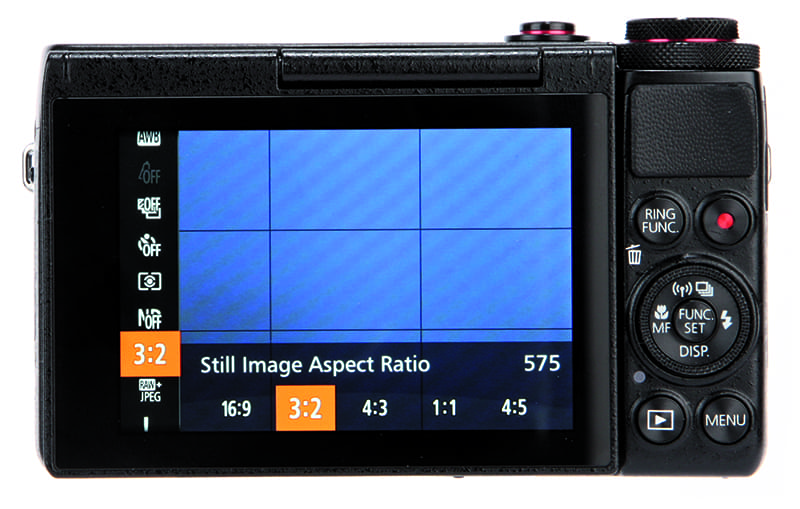 Continuous autofocus across 31-points covering a large area of the frame with subject tracking is possible at a reduced 4.4fps, but at this frame rate, there is just as much merit in anticipating the shot yourself and nailing it in one frame, of course some will appreciate the cushion of an extra couple of frames.
Continuous autofocus across 31-points covering a large area of the frame with subject tracking is possible at a reduced 4.4fps, but at this frame rate, there is just as much merit in anticipating the shot yourself and nailing it in one frame, of course some will appreciate the cushion of an extra couple of frames.
The G7 X also features a built-in ND filter which makes it possible to shoot with the aperture wide open in bright light to give maximum background blur for portraits. It also enables the user of slower shutter speeds in broad daylight, making it easier to capture smooth flowing water, trailing motion or shallow field portraits on sunny days.
The combination of HS System and new processor should also deliver images with greater detail in low light but I’ve found in practise that when shooting jpeg images, Canon’s own noise-handling algorithms in the G7 X are a touch too aggressive for my liking, rendering the images slightly softer than they appear compared to what you can do with the raw versions of the same shots.
But for me the marquee feature on this camera has got to be its fast f/1.8-2.8 lens with optical image stabilisation, better equipping it for handheld lowlight shooting as well as creating strong separation between subjects and the background. The lens also has 4.2x optical zoom giving it an equivalent focal range of 24-100mm, covering a wide variety of photographic applications, including landscape pictures and portraits. It also has a close minimum focusing distance of 5cm from front of the lens at 24mm, ideal for macro subjects.
During video recording, 5-axis movie stabilisation kicks in to try and keep footage smooth and steady, and it does a good job of anticipating and countering camera shake. Other great video features include MP4 codec full HD 60p movie recording with stereo audio, manual focus peaking, adjustable shutter speed control and manual aperture control during filming that can be adjusted using the touch screen on the rear of the camera to avoid camera movement.
Build and Handling
Canon PowerShot G7 X Review – Build and Handling
At first sight the Canon PowerShot G7 X looks like a highly attractive premium model with its refined speckled metal body and anodised red aluminium detailing below the shutter and mode dials. Measuring just 103mm x 60.4mm x 40.4mm it has a good weight-to-size ratio at 304g. On the front of the camera, Canon has placed a control ring around the lens that can be set to control a number of parameters, including shutter speed and ISO, however leaving it on aperture control was my preference. A very satisfying click occurs as the metal ring is turned, adding to the tactile experience of shooting manually.
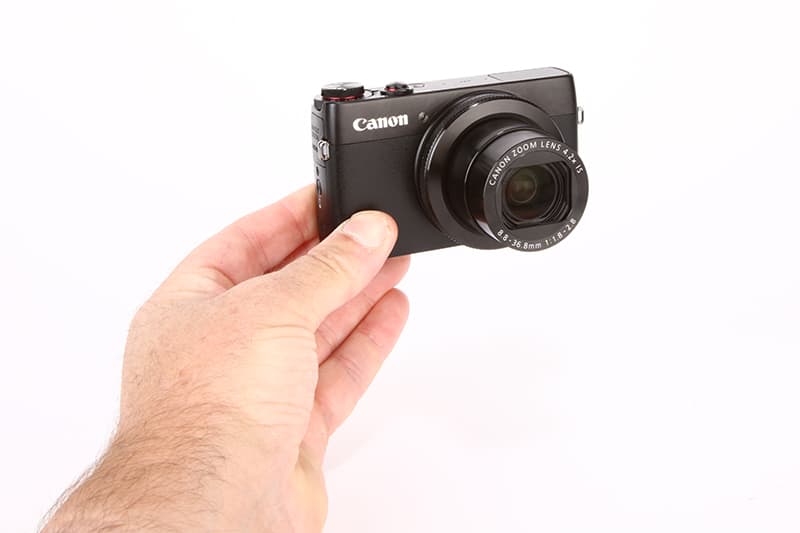
This setup enabled me to adjust the shutter settings on the rear control dial, while exposure compensation can be manipulated ±3 stops in 1/3-stop increments using the dedicated EV dial, positioned beneath the mode dial. Having dedicated controls for EV is great, although I feel Canon has positioned it too tightly beneath the mode dial, making it unnecessarily tough to adjust, especially when wearing gloves.
The G7 X also features a 1.04-million-dot 3in capacitive touch panel LCD screen that can be tilted 180° to face forwards for taking group or self-portraits. I found the touchscreen highly responsive, and great for swiping through images during playback, but it is especially useful for adjusting settings during movie recording when moving the physical controls would otherwise cause unwanted camera shake.
The screen is clearly visible in most conditions and the colours displayed closely match the JPEG images captured using the G7 X. The camera features a small built-in pop-up flash with a stated range of 5cm – 7m (W) and 40cm – 4m (T) on Auto ISO. I found the results of using flash to be even and not too overpowering – it performed well, even in conditions of darkness.
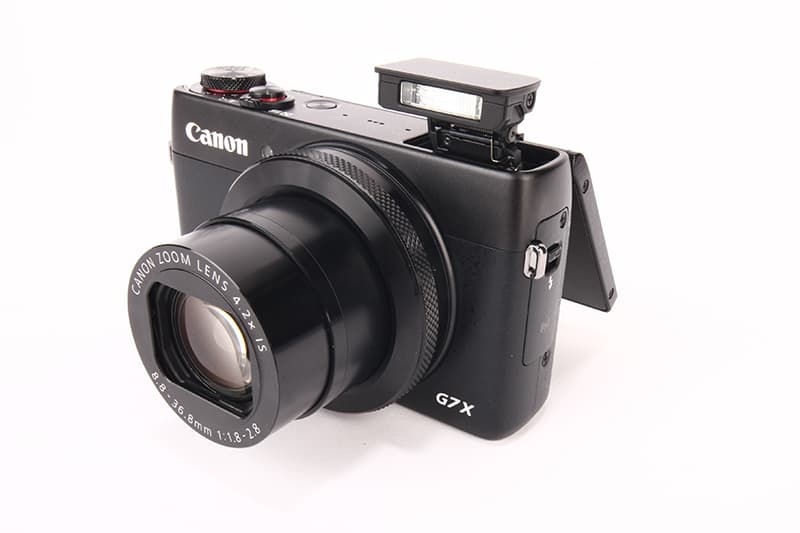
Despite my slight issue with the exposure compensation dial, the controls of the GX 7 are sensibly placed, which along with the clicking lens control ring and the raised texturised rubber thumb rest for grip all contribute to making this a pleasant camera to shoot with.
Performance
Canon PowerShot G7 X Review – Performance
See more images taken with the Canon PowerShot G7 X in our sample gallery
 This camera is Canon’s first-ever 1-inch sensor product and its raison d’être rests almost entirely on its ability to show an improvement on the Canon PowerShot G16, while matching or surpassing the quality of the G1 X Mark II in its smaller frame. I’m pleased to say that this camera is indeed capable of capturing images that can be displayed proudly besides those from the G1 X Mark II and it’s noticeably better than the G16 in my opinion. Images captured on this camera are generally rich in colour and look good at 100%. In high-contrast scenes the camera is capable of capturing a wide range of tones, and battles overexposure well, while still maintaining detail in the shadowed areas.
This camera is Canon’s first-ever 1-inch sensor product and its raison d’être rests almost entirely on its ability to show an improvement on the Canon PowerShot G16, while matching or surpassing the quality of the G1 X Mark II in its smaller frame. I’m pleased to say that this camera is indeed capable of capturing images that can be displayed proudly besides those from the G1 X Mark II and it’s noticeably better than the G16 in my opinion. Images captured on this camera are generally rich in colour and look good at 100%. In high-contrast scenes the camera is capable of capturing a wide range of tones, and battles overexposure well, while still maintaining detail in the shadowed areas.
I found it quite easy to further recover details from challenging areas in post-production using the raw files, but this was also possible to some extent with the compressed jpeg images. Capture and processing speed was one area where the performance wasn’t as good as I’d expected, particularly with creative options such as HDR. Additionally, its maximum burst speed of 6.5fps isn’t quite good enough when higher speeds are possible in rival devices.

Autofocus
Canon’s G7 X focusing system comprises 31 contrast-detection autofocusing points with Artificial intelligence Auto Focus (AiAF). In use I found the system responsive and more than adequate for typical shooting scenarios, such as pictures of inanimate objects, friends and family members or party scenes.
 But relying on a contrast detection method, it can be a fraction slower than I’d like, particularly in low-light scenarios where AF-assist beam can be activated to provide some assistance. It’s also noticeably slower as you approach the telephoto end, in comparison to its focusing speed at 24mm. Those interested in shooting macro images will find the lens’ closest focusing distance of 5cm at its wideangle an attractive prospect.
But relying on a contrast detection method, it can be a fraction slower than I’d like, particularly in low-light scenarios where AF-assist beam can be activated to provide some assistance. It’s also noticeably slower as you approach the telephoto end, in comparison to its focusing speed at 24mm. Those interested in shooting macro images will find the lens’ closest focusing distance of 5cm at its wideangle an attractive prospect.
Close inspection of images captured in macro focusing mode, shot at the lens’ widest aperture setting of f/1.8 reveals a decent level of detail, the colours are spot on, and the shallow depth-of-field is attractive, but the in-focus area is a touch soft, lacking the sharpness that I’d hope for when shooting macro subjects. Being able to use the screen to activate focusing at a touch is great and definitely speeds things up when trying to focus on a specific part of your composition that isn’t in the centre of the frame.
 See more images taken with the G7 X in our sample gallery
See more images taken with the G7 X in our sample gallery
Touch focusing is also available during video recording and can be used smoothly select focusing areas when continuous AF is selected. Focus peaking during manual focusing mode is another useful feature that is available to assist focus during macro and video recording.
Resolution, Dynamic Range and Noise
Canon PowerShot G7 X Review – Resolution, Dynamic Range and Noise
The G7 X uses a 20-million-pixel one-inch BSI-CMOS sensor – very substantial for an easily pocket-able compact. Although the ISO range doesn’t extend beyond 12800 this is compensated for by the bright zoom lens, which allows shooting at relatively lower ISO settings in low light. Dynamic range is excellent at low ISOs, you could therefore extract lots of detail from deep in the shadows in raw processing. Although the G7X wasn’t supported in Adobe Camera RAW at the time of testing, a thorough inspection in Canon’s Digital Photo Pro gave a taste of the quality achievable with noise reduction and sharpening applied. The camera’s accurate metering modes can help to get the best exposures for raw shooters, by minimising clipping in bright areas of the image.
Image quality is excellent at sensitivities up to ISO 1600, but at higher ISOs it naturally deteriorates. However ISO 3200 and 6400 are absolutely fine for less-critical purposes, especially if carefully processed from raw. At the highest ISOs JPEGs suffer from colour noise and detail loss, and while better results can be had from raw, this will usually come at the cost of colour saturation. Overall the G7 X is a delight to use with quite exceptional results for its size.
Resolution
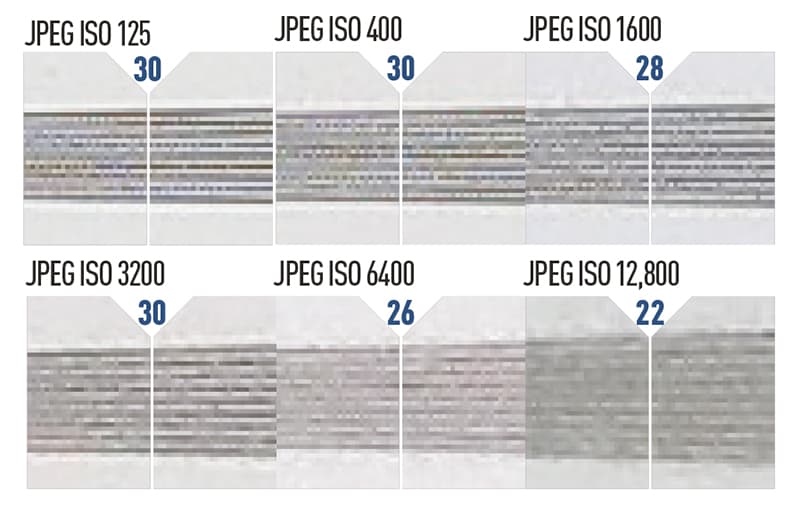
The G7 X uses a 20-million-pixel one-inch BSI-CMOS sensor – very substantial for an easily pocket-able compact. Although the ISO range doesn’t extend beyond 12800 this is compensated for by the bright zoom lens, which allows shooting at relatively lower ISO settings in low light. Dynamic range is excellent at low ISOs, you could therefore extract lots of detail from deep in the shadows in raw processing.
Although the G7X wasn’t supported in Adobe Camera RAW at the time of testing, a thorough inspection in Canon’s Digital Photo Pro gave a taste of the quality achievable with noise reduction and sharpening applied. The camera’s accurate metering modes can help to get the best exposures for raw shooters, by minimising clipping in bright areas of the image.
Image quality is excellent at sensitivities up to ISO 1600, but at higher ISOs it naturally deteriorates. However ISO 3200 and 6400 are absolutely fine for less-critical purposes, especially if carefully processed from raw. At the highest ISOs JPEGs suffer from colour noise and detail loss, and while better results can be had from raw, this will usually come at the cost of colour saturation. Overall the G7 X is a delight to use with quite exceptional results for its size.
Dynamic range
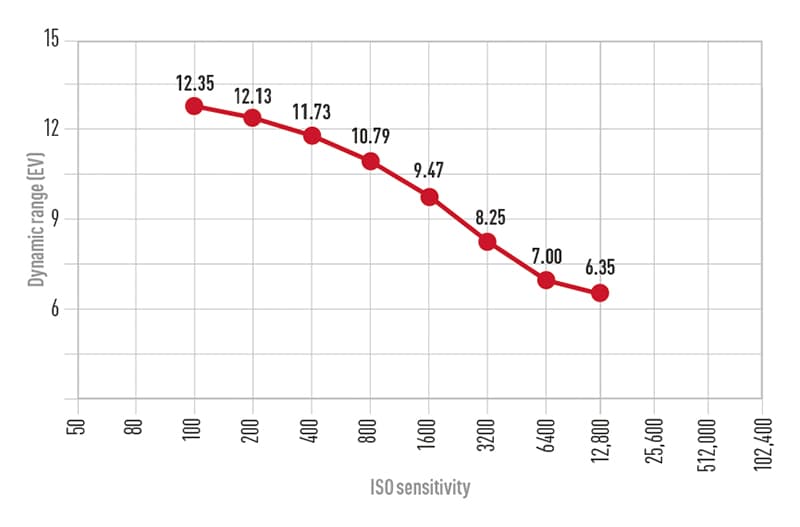
The G7 X sensor delivers excellent results, on a par with the Sony RX100 cameras. At ISO 125, the peak dynamic range is 12.4EV, and the sensor is still performing well at ISO 1600 with a range of 9.5EV, dropping away quite significantly at its maximum ISO 12800. This is indicative of the G7X’s ability to retain good detail in the shadow areas. In practice, with the GX7’s fast lens and effective image stabilisation, the highest ISO setting would really be used as an emergency measure in very low light.
Colour
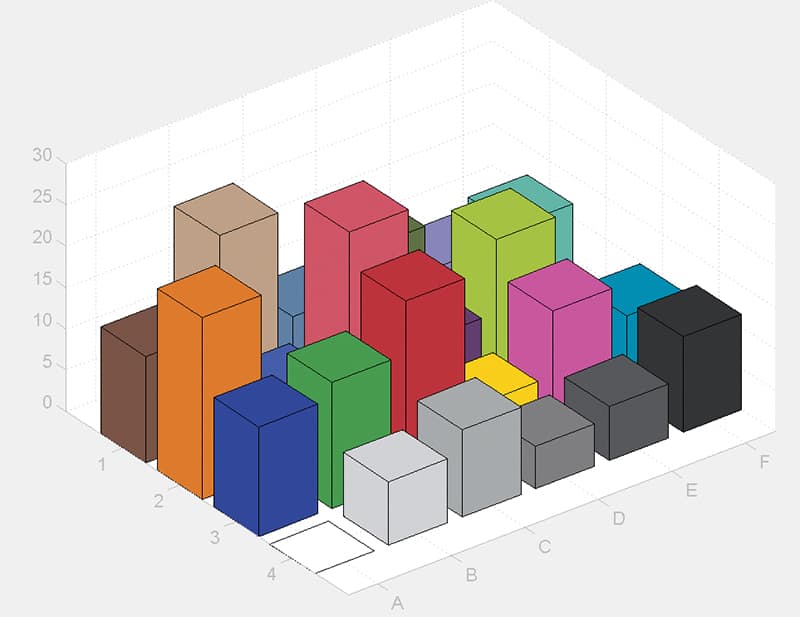
This 3D graph compares the colour shift from the reference colour to the photographed chart: the higher the peak, the greater the shift from the original colour. In the default JPEG colour setting, colours are well rendered across the range, with the balance seemingly adjusted towards good skin tone rendition. Test images display generally natural colour rendition in standard JPEG mode, with good saturation and contrast; the accentuated blues should be particularly good for skies in landscape photography. Colour rendition can of course be adjusted in the menu settings.
Noise

The images above have a resolution of 300ppi and are shown at 100% magnification, reflecting a full-resolution print size. The G7 X produces clean, detailed images at its lowest sensitivity settings of ISO 125 to ISO 400. Some luminance noise starts to become visible at ISO 800, along with visible effects of noise reduction, but images remain perfectly usable up to ISO 1600. At ISO 3200 and above, chroma noise starts to appear in the JPEGs, especially in shadow regions. However this can be removed in raw processing with little impact on detail. The penalty, however, is pronounced luminance noise coupled with a loss of colour saturation. Images are still quite useable at ISO 6400, and even at ISO 12800 with careful processing.

The grey-card images above are JPEG files shot with the G7 X’s default noise reduction and colour settings applied. The 300ppi images are shown at 100% magnification to reflect the noise that would be experienced when printing an image at maximum size.
The results show the G7 X is almost noise-free up to ISO 400, and still gives fairly clean images at ISO 1600. Noise starts to become obvious at higher settings, and by ISO 6400 both colour and luminance noise are starting to kick in. The ISO 12,800 setting should really be considered as a standby for emergency use.
Verdict
Canon PowerShot G7 X Review – Verdict
The G7 X is Canon’s first foray into the 1-inch-sensor compact camera market and given that this section has been dominated almost exclusively by Sony’s RX100 series, the G7 X is a welcome contender. The RX100 Mark III has a neat pop-up OLED viewfinder and for some the lack of any equivalent on the G7 X may be the deal breaker, but in its defence, the Canon offers a more extended zoom range of 24-100mm versus 24-70mm. It also handles slightly better in my opinion, with controls and menus sensibly placed and easy to navigate.
Panasonic’s new LX100 also offers some competition to the G7 X with some great features that the Canon model simply can’t match, such as 4K video recording and 4K stills capabilities.
I found the 90° tilt screen very useful when trying to get low angle shots, but occasionally my efforts were frustrated whenever I wanted to shoot at an alternative angle, as the screen only titled upwards. Of course you can connect the camera to a smart device quite easily and control it remotely to get around this issue, but some photographers may not have this option. It’s not a big issue but the screen’s lack of mobility is somewhat limiting.
My wish list of improvements I’d have liked to see in the G7 X include an advanced hybrid AF system, faster image processing with a higher frame rate during burst shooting, a multi-interface accessory hotshoe and weather sealing, but we can’t have it all (yet). But with all of that being said, at around £570, Canon’s model is the cheapest of the pack and offers a lot of benefits, including superb manual handling in a truly portable frame, weighing significantly less than Panasonic’s LX100 and fitting neatly into trouser pockets.
First Look
[brightcove videoID=3794586364001 playerID=940176129001 height=400 width=630]
See our gallery of sample images of the G7 X
Around five years ago, Canon invented essentially a new class of camera. The Powershot S90 combined decent image quality and enthusiast-friendly controls in a truly pocketable form factor. For a while Canon had this section of the market almost to itself, with successive iterations of the S series holding the affections of photographers who wanted a small camera to carry around with them at all times, without completely sacrificing creative control.
This all changed in mid-2012, when Sony announced the Cyber-shot RX100. This took the same essential concept but used a much larger, 1-inch type 20-million-pixel sensor for vastly better image quality. The RX100 captured the imagination of serious photographers, and along with Sony’s later models, the RX100 II and III, it has been essentially unchallenged since as the serious photographer’s pocket camera of choice. Now Canon has hit back again, with the Powershot G7 X.

The G7 X looks very much like an S-series Powershot, and is only slightly thicker; at first glance you might be forgiven for mistaking it as a minor update. But like the RX100 series it uses a 1-inch type 20-million-pixel sensor, offering sensitivities up to ISO 12800, which we have to assume will be a very similar unit. This makes it the first direct competitor Sony has faced in this premium enthusiast compact sector.
The G7 X’s trump card, though, is its lens; a 24-100mm equivalent optic with an impressively-fast f/1.8-2.8 maximum aperture. This covers a range from landscape-friendly wideangle to short telephoto for portraits, while offering a fast aperture that’s good for low-light shooting, and should allow some creative background blur. Purely in terms of specification, the Canon’s lens beats both the 28-100mm equivalent f/1.8-4.9 used by the RX100 and RX100 Mark II, and the RX100 III’s 24-70mm equivalent f/1.8-2.8.
The maximum aperture holds up well as you zoom in too, rather than falling quickly. It’s f/2.8 at 28mm equivalent, f/2.2 at 35mm equiv, f/2.5 at 50mm equiv, and f/2.8 at 85mm equiv. In principle this should offer better depth of field control, and more background blur, than the 18-55mm f/3.5-5.6 kit zooms generally supplied with DSLRs and CSCs.
This combination of lens and sensor makes the G7 X pretty exciting, but Canon has also paid a lot of attention to building a photographer-friendly control layout. It has a top-plate exposure compensation dial, with a +/- 3EV range in 1/3 stop increments. There’s a control dial around the lens for adjusting exposure settings, and many photographers will be delighted to hear that unlike on the RX100s, it has click stops to give tactile feedback that settings have been changed.

The G7 X features a touch-screen LCD that can flip upwards for waist-level shooting, and even face fully forwards for self-portraits. But it can’t tilt downwards or sideways, which limits its usefulness compared to the fully articulated screens that users of older Canon G-series models will fondly remember. The touchscreen allows you to position the AF point anywhere in the frame just by tapping on the screen, and can also be used to release the shutter if you want.
In terms of video, Full HD recording at 1920 x 1080 pixels resolution is available at up to 60 frames per second. When the mode dial is set to the dedicated movie position, full manual exposure control is available; in other modes, video recording settings are fully automatic. Sound is recorded via stereo microphones on the top plate.
Like most modern cameras the G7 X has built-in Wi-Fi. It’s also equipped with NFC for easy pairing with a smartphone or tablet, and simply tapping the devices together will establish a connection and open the Canon app. There’s also a dedicated button on the side of the camera for firing up the connection, for use with devices which don’t have NFC.

One area of possible concern is battery life; the G7 X takes the NB13L battery, which offers just 210 shots per charge, or 310 with the camera set to its power-aving ‘Eco’ mode. We expect most serious users will want to carry a spare or two.
First impressions

The Canon Powershot G7 X is the first model to directly challenge the Sony RX100 series in the 1-inch sensor, pocketable camera class, and from our initial handling of the camera it looks like Canon has a particularly strong contender on its hands. The lens offers a very impressive combination of zoom range and maximum aperture, and we think the control layout will be viewed more favourably by stills shooters too, with the top-plate exposure compensation dial and click-stopped lens ring.
The Canon doesn’t have everything its own way, though; the Sony RX100 III has a built-in pop-up electronic viewfinder, and should have the edge when it comes to video image quality. The RX100 series’ clickless lens dial is also favoured by video shooters for changing settings while recording.
Overall though we’re pretty excited by the G7 X, and it’s great to see some real competition in this category at last. The Canon looks like it should be a very strong contender, too, so check back for our full review when we’ll tell you in detail how it performs.





